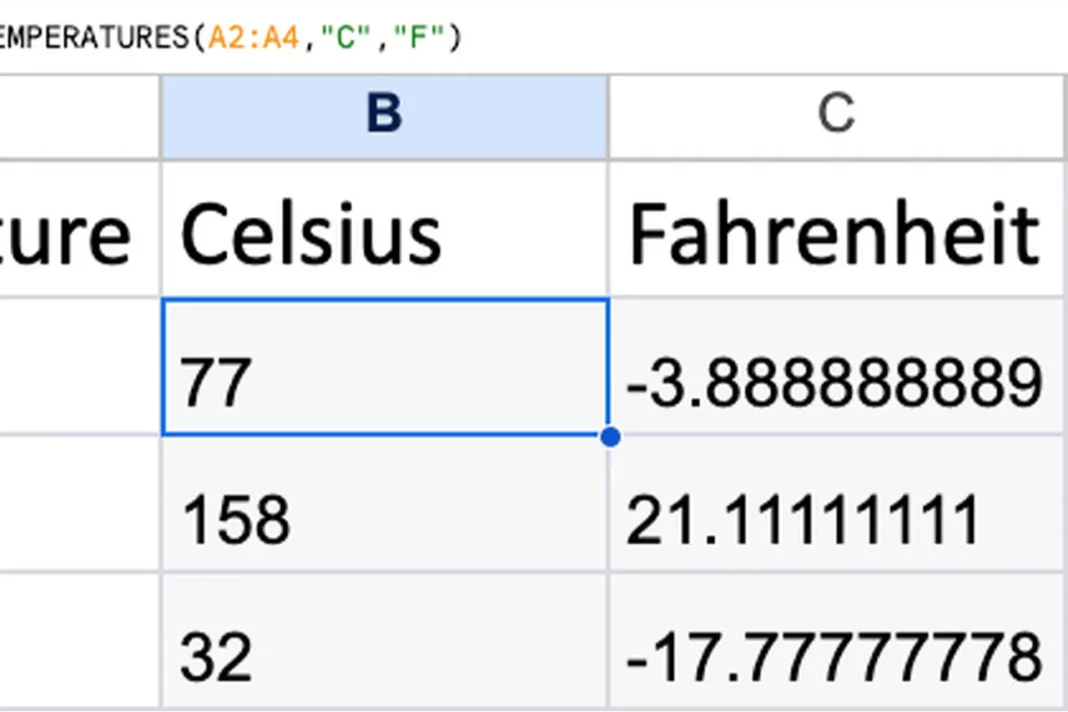Are you tired of trying to convert temperatures from Celsius to Fahrenheit? Look no further! In this article, we will explore the simple and straightforward method to convert Celsius to Fahrenheit, so you can easily make sense of temperature readings and forecasts. Whether you’re planning a trip to a foreign country or just want to understand the weather better, this guide will equip you with the knowledge you need. Say goodbye to confusion and hello to accurate temperature conversions!
Have you ever wondered how to convert Celsius to Fahrenheit and vice versa? Well, wonder no more! In this article, we will demystify the process of converting Celsius to Fahrenheit, making it a breeze for you. With just a few simple steps, you’ll be able to confidently convert temperatures and understand the differences between the two scales. Whether you’re a student studying science or just curious about the weather, this guide is for you. Get ready to unlock the secrets of temperature conversions and impress your friends with your newfound knowledge!
Why Convert Celsius to Fahrenheit?
Why Convert Celsius to Fahrenheit?
Celsius and Fahrenheit are the two most commonly used temperature scales worldwide. Understanding how to convert temperatures between these two scales is crucial for a variety of reasons:
- Scientific Research: Scientists and researchers often work with data in both Celsius and Fahrenheit. Converting temperatures allows them to analyze and compare data accurately.
- International Travel: Many countries use Celsius as their primary temperature scale. Being able to convert temperatures to Fahrenheit is essential for travelers from countries that use the Fahrenheit scale.
- Personal Comfort: Understanding temperature conversions helps individuals determine how hot or cold it will feel in different regions or climates.
| Celsius |
Fahrenheit |
| 0°C |
32°F |
| 10°C |
50°F |
| 20°C |
68°F |
| 30°C |
86°F |
| 40°C |
104°F |
Converting Celsius to Fahrenheit can be done using the formula:
°F = (°C × 9/5) + 32.
By mastering the art of converting Celsius to Fahrenheit, individuals can confidently navigate varying temperature scales and make informed decisions based on the information available.
The Formula for Celsius to Fahrenheit Conversion
Converting temperatures from Celsius to Fahrenheit is a straightforward process that can be achieved by using a simple formula. By understanding this formula, individuals can accurately convert temperatures and make informed decisions based on the temperature scale they are most comfortable with.
The formula for converting Celsius to Fahrenheit is as follows:
°F = (°C × 9/5) + 32
In this formula, °C represents the temperature in Celsius, and °F represents the equivalent temperature in Fahrenheit. To convert Celsius to Fahrenheit, you multiply the Celsius temperature by 9/5 and add 32.
Understanding and utilizing this conversion formula is essential for a variety of practical applications, including:
- Scientific Research: Scientists and researchers often work with data in both Celsius and Fahrenheit. Having the ability to convert temperatures accurately allows them to analyze and compare data effectively.
- International Travel: Travelers visiting countries that use the Fahrenheit scale, such as the United States, need to convert temperatures to better understand local weather conditions or plan their activities accordingly.
- Climate Analysis: Individuals wanting to understand how hot or cold it will feel in different regions or climates can convert temperatures from Celsius to Fahrenheit to get a clearer picture.
The formula for converting Celsius to Fahrenheit is a valuable tool for accurately converting temperatures. By mastering this formula, individuals can confidently navigate varying temperature scales and make informed decisions based on their temperature preferences.
Examples of Celsius to Fahrenheit Conversion
When it comes to converting temperatures from Celsius to Fahrenheit,
practice makes perfect. Here are a few
illustrative examples to help cement your understanding of the conversion formula:
- Boiling Point: Water boils at 100 degrees Celsius and 212 degrees Fahrenheit.
- Freezing Point: The freezing point of water is 0 degrees Celsius and 32 degrees Fahrenheit.
- Body Temperature: The average human body temperature is approximately 37 degrees Celsius and 98.6 degrees Fahrenheit.
- Extreme Temperatures: Let’s say it’s scorching hot at 40 degrees Celsius. In Fahrenheit, it would be a sweltering 104 degrees!
- Weather Forecasts: In checking the weather forecast, you might come across temperatures like 25 degrees Celsius or 77 degrees Fahrenheit.
These examples demonstrate the relevance and practicality of mastering the Celsius to Fahrenheit conversion formula. By confidently navigating between temperature scales, individuals can ensure accurate measurements, make informed decisions, and adapt to varying climates.
The Formula for Fahrenheit to Celsius Conversion
When it comes to converting temperatures from Fahrenheit to Celsius, there is a simple formula that can be used. This formula allows for an accurate conversion between the two temperature scales. The formula for Fahrenheit to Celsius conversion is:
C = (F – 32) * 5/9
In this formula, “C” represents the temperature in Celsius, while “F” represents the temperature in Fahrenheit. By plugging in the Fahrenheit temperature into the formula and performing the necessary calculations, the temperature can be converted to Celsius.
Understanding and utilizing this conversion formula is essential in various fields and applications. For scientific research, it is crucial to be able to convert temperatures accurately, especially when working with data gathered from different sources or when collaborating with researchers from around the world. International travel also requires familiarity with the Celsius temperature scale, as many countries outside of the United States use Celsius as the standard temperature unit.
Additionally, climate analysis relies on accurate temperature conversions. By converting temperatures between Fahrenheit and Celsius, researchers can effectively study and compare climate patterns and variations across different regions. Weather forecasting and analysis also benefit from understanding Celsius to Fahrenheit conversions, as it allows meteorologists to communicate temperature information in a universally understandable way.
Mastering the Fahrenheit to Celsius conversion formula opens up a world of possibilities. It enables individuals to make accurate measurements, informed decisions, and adapt to varying climates. By confidently navigating between temperature scales, professionals in various fields can ensure the accuracy of their work and contribute to advancements in their respective domains.
Examples of Fahrenheit to Celsius Conversion
Fahrenheit to Celsius conversion is a crucial skill in various fields, from scientific research to weather forecasting. Below are some examples of Fahrenheit to Celsius conversion to showcase its practical applications:
- Boiling and Freezing Points: Water boils at 212°F (100°C) and freezes at 32°F (0°C).
- Body Temperature: Average human body temperature is approximately 98.6°F (37°C).
- Extreme Temperatures: For extreme heat, 100°F is equivalent to 37.8°C, while extreme cold at -10°F translates to -23.3°C.
- Weather Forecasts: Temperature forecasts often provide both Fahrenheit and Celsius readings, enabling individuals to understand the weather conditions.
Remember, mastering Fahrenheit to Celsius conversion is essential for accurate scientific analysis, international travel, climate analysis, and weather forecasting purposes.
Tips for Remembering the Conversion Formula
Converting temperatures from Celsius to Fahrenheit can be challenging, but there are some helpful tips to remember the formula easily:
- Use the mnemonic “Double it and add 30” to recall the formula: F = (C x 2) + 30.
- Break down complex calculations by rounding the Celsius temperature to the nearest whole number.
- Familiarize yourself with common Celsius to Fahrenheit conversion benchmarks. For example, 0°C is 32°F, and 100°C is 212°F.
- Practice by converting different Celsius temperatures to Fahrenheit regularly to improve your memorization.
Conclusion
Converting temperatures from Celsius to Fahrenheit is an essential skill for various fields and everyday life. By understanding and utilizing the conversion formula, individuals can navigate scientific research, international travel, and climate analysis more effectively. The boiling and freezing points of water, average human body temperature, extreme temperatures, and weather forecasts are just a few examples of where this conversion is relevant.
To remember the conversion formula, a simple mnemonic like “Double it and add 30” can be helpful. Additionally, rounding the Celsius temperature to the nearest whole number simplifies the process. Familiarizing oneself with common Celsius to Fahrenheit conversion benchmarks and practicing conversions regularly can also improve memorization.
Whether you’re a scientist, a traveler, or someone who wants to better understand the weather, mastering the Celsius to Fahrenheit conversion is a valuable skill. By being able to convert temperatures accurately, you’ll have a deeper understanding of the world around you and be better equipped to make informed decisions based on temperature data. So, start practicing and make this conversion formula second nature!
Frequently Asked Questions
Q: Why is it important to convert temperatures from Celsius to Fahrenheit?
Converting temperatures from Celsius to Fahrenheit is important for scientific research, international travel, and climate analysis. It allows for better understanding and comparison of temperature measurements across different systems.
Q: How do you convert Celsius to Fahrenheit?
To convert Celsius to Fahrenheit, you can use the formula: Fahrenheit = (Celsius × 9/5) + 32. This formula ensures accurate conversion between the two temperature scales.
Q: When would I need to convert Celsius to Fahrenheit?
Conversions from Celsius to Fahrenheit are commonly needed in various scenarios, such as determining the boiling and freezing points of water, understanding average human body temperature, analyzing extreme temperatures, and interpreting weather forecasts.
Q: How can I remember the Celsius to Fahrenheit conversion formula?
A helpful way to remember the formula is the mnemonic “Double it and add 30.” Another tip is to round the Celsius temperature to the nearest whole number for a quick approximation.
Q: Are there any common benchmarks I should be aware of for Celsius to Fahrenheit conversions?
Yes, becoming familiar with commonly encountered Celsius to Fahrenheit conversion benchmarks is useful. For example, 0°C is approximately 32°F, 20°C is about 68°F, and 37°C represents the average human body temperature of 98.6°F.
Q: What can I do to improve my memorization of Celsius to Fahrenheit conversions?
Regular practice plays a vital role in improving memorization. By actively practicing converting temperatures, you can reinforce the conversion formula in your memory and become more proficient in performing accurate Celsius to Fahrenheit conversions.




